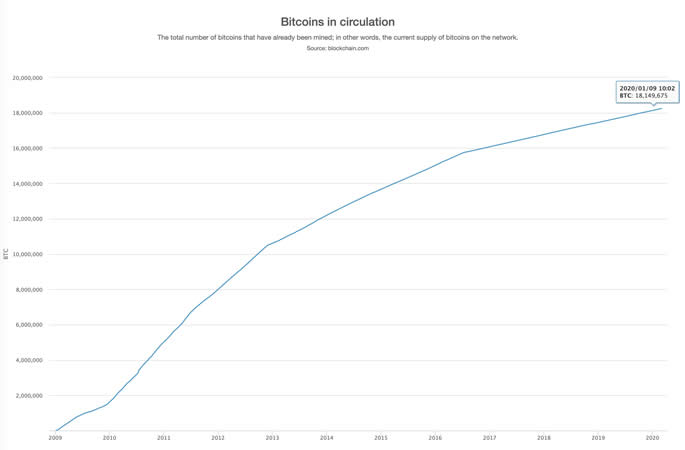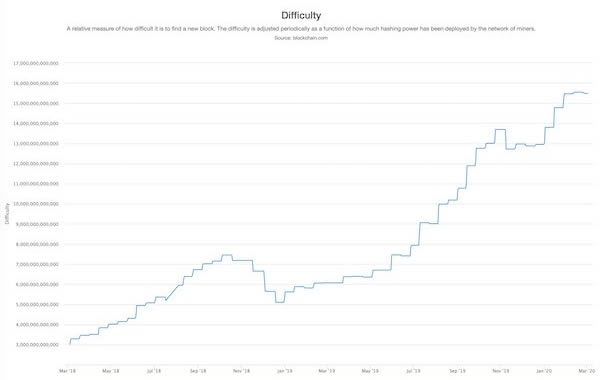In understanding how bitcoin works, we start by looking at the bitcoin supply parameters, followed by the roles played by bitcoin mining and the blockchain, which are explained in greater detail in the next sections.
The Bitcoin Supply Parameters
The mining of bitcoin which ultimately governs its supply and release into circulation is determined by the Bitcoin code that revolves around the following three main supply parameters:
- 21 million bitcoin – a known finite total supply
- Halving rate – a predictable diminishing rate of supply
- Mining difficulty adjustment – A steady consistent rate of supply
21 Million Bitcoin
- There will ever only be a total of 21 million bitcoin in existence and in circulation by the year 2140.
- It is unclear why the number of 21 million was chosen, but the reason a limit was set is so that bitcoin would demonstrate a character similar to gold (a finite supply) rather than the fiat currencies of the central banking system and the inflation of the money supply through quantitative easingQuantitative easing is an unconventional monetary policy in which a central bank purchases government securities or other securities from the market in order to increase the money supply and encourage lending and investment and to provide banks with more liquidity. If central banks increase the money supply, it can cause inflation. In a worst-case scenario, the central bank may cause inflation through quantitative easing without economic growth..
- A fixed limited total supply creates scarcity and helps to make bitcoin a deflationaryCharacterised by or tending to cause an economic situation where there is a general decline in prices for goods and services, typically associated with a contraction in the supply of money and credit in the economy. During deflation, the purchasing power of currency rises over time. currency, as long as the demand for it exists and continues to grow.
- As of 2020, more than 18 million bitcoin have already been released into circulation through the mining process. This is more than 85% of all bitcoin there will ever be. See Fig. 1.4a below.
- The remaining less than 3 million bitcoin i.e. less 15% of the total supply will be mined over the next 100+ years, until the year 2140.
- This disproportionate non-linear supply is due to the halving rate which is baked into the Bitcoin code.

Fig. 1.4a As of 2020, more than 18 million bitcoin have already been created. The updated cumulative total number of bitcoin in circulation can be found at https://www.blockchain.com/charts/total-bitcoin
Halving Rate
In explaining this, the terms miningThe process by which bitcoin transactions are validated and new bitcoin are created., blockA virtual container of bitcoin transactions created about every 10 minutes on average., hashrateA measure of computing power of mining hardware measured in hash per second., puzzleA cryptographic mathematical challenge that miners need to solve for each block to validate the contained bitcoin transactions and to earn the mining rewards. etc. may seem foreign at first. Just read through this, and over the next few chapters, it will all begin to make more sense.
- Bitcoin transactions are placed into a block with a cryptographic puzzle that is solved by a miner roughly every 10 minutes.
- In solving the puzzle for that block, the transactions therein are thus validated and the successful miner is awarded a preset number of bitcoin for each block as a reward.
- This is how new bitcoin are “minted” and released into circulation for use. More on this in the next chapter.
- The block mining rewards are designed to be halved after every 210,000 blocks.
- At the rate of roughly 10 minutes per block, this halving would occur after every 4 years.
Calculation: 210,000 blocks x 10 mins = 35,000 hours = 1,458 days = 3.99 years - At the beginning of bitcoin’s existence in early 2009, the preset number of bitcoin was 50 BTC per block. This is known as Reward Era 1. See Table 1.4b below.
- The first halving occurred almost 4 years later on 28th November 2012, where the mining reward for Block No. 210,000 onwards was 25 BTC per block. This is known as Reward Era 2.
- The second halving occurred 4 years after that on 9th July 2016, where the mining reward for Block No. 420,000 onwards was reduced to 12.5 BTC per block. This is known as Reward Era 3.
- The third halving occured on 11th May 2020, where the mining reward for Block No. 630,000 onwards was reduced to 6.25 BTC per block. This is known as Reward Era 4.
- These halvings would continue to take place after every 210,000 blocks or about every 4 years until the year 2140 when no more new bitcoin will be created. By this time, all 21 million bitcoin would be in circulation.
- After 2140 when no more new bitcoin will be created, block rewards to the miners shall be solely from transaction fees. Number of transactions per block at this time is expected to be higher and the total amount from transaction fees is presumed to be significant enough to incentivise miners to continue validating blocks.
- The halving of bitcoin mining reward is a well thought out feature because:
- It allows ample time for bitcoin to be understood and adopted and spreads the demand for bitcoin over a long period. If there was no halving, all 21 million bitcoin would be released in a matter of 8 years instead of over 100 years. The demand and interest in bitcoin could have then fizzled out not long after its creation.
- It allows for a more controlled supply and demand scenario. With a foreseeable increasing demand and an established decreasing supply over time, bitcoin value could be expected to grow in tandem for it to be what it was designed to do at a more appropriate time in the future.
- As bitcoin’s value and its demand increase, more miners are expected to join the network. As the supply gets reduced over time and more electricity is expended to mine it, the price of bitcoin would have to naturally increase to cover the costs of mining. After all, mining is where all bitcoin come from. We wouldn’t be able to imagine gold to be sold at a price lower than what it costs to mine them. Gold mining companies would go out of business.
- However, with more miners joining the network, the block puzzles would be solved much quicker than its designed 10 minute rate. If this were to happen, the 210,000 blocks would arrive much sooner and the halvings would take place earlier. As a result, all 21 million bitcoin could be released by 2025 (way before 2140), thus not giving it enough time to mature as a technology or to be timed for gradual mainstream adoption.
One would think 10 years is a long time these days for technology to gain foothold, but as at 2020, more than a decade after bitcoin was created, many still do not understand bitcoin well enough. - As it turns out, built into the Bitcoin code is a mining difficulty adjustment.
| Reward Era | Year | Date Reached | Block No. | BTC per block | BTC Added |
|---|---|---|---|---|---|
| 1 | 2009 | 03 Jan 2009 | 0 | 50.00 | 10,500,000 |
| 2 | 2012 | 28 Nov 2012 | 210,000 | 25.00 | 5,250,000 |
| 3 | 2016 | 09 Jul 2016 | 420,000 | 12.50 | 2,625,000 |
| 4 | 2020 | 11 May 2020 | 630,000 | 6.25 | 1,312,500 |
| 5 | 2024 | Expected 2024 | 840,000 | 3.125 | 656,250 |
| …and so on until Year 2140 | |||||
Table 1.4b Summary table of mining reward over time, date reached and bitcoin added into circulation.
Mining Difficulty Adjustment
- Expecting blocks to be solved earlier than their supposed 10-minute period as more miners joined the network, the puzzle or mining difficulty is adjusted every 2,016 blocks, or 14 days.
Calculation: 2,016 block x 10 mins = 336 hours = 14 days - This adjustment is based on the time it took for miners to solve for the previous 2,016 blocks.
- If the previous 2,016 blocks took less than 14 days to find or create, the mining difficulty is increased.
- This would restore the solving of the next 2,016 blocks to 14 days again, thereby making the time it takes to solve each block to the intended average of 10 minutes.
- On the contrary, if the previous 2,016 blocks took more than 14 days to create, the mining difficulty is reduced.
- Mining difficulty is a relative measure of how difficult it is to find a new block. This is expressed as an absolute number which describes how much harder it is for a miner to solve for the current block with respect to the first block mined in 2009.
Example: The mining difficulty on 9th January 2019 was 5,618,595,848,853, which indicates that a block in early 2019 was over 5 trillion times harder to solve than the first block a decade ago in early 2009. - Mining difficulties are expected to go up and down over time as miners join and leave the network for various reasons. Generally over the long term, the number of miners increase and add hashrate to the network, leading to an upward trend in mining difficulty.
- This self-regulated rate of mining reward is critical to keep the supply or the minting of new bitcoin under control so that it stays on its intended track.

Fig. 1.4c Chart indicating mining difficulty over time is found at https://www.blockchain.com/charts/difficulty
It would seem that Satoshi had thought of just about everything to keep the Bitcoin project sustainable over the long term.
The phenomenon that makes everything we have discussed above possible is known as bitcoin mining, which we will explore next in 1.5 What is Bitcoin Mining.

 World's No.1
World's No.1